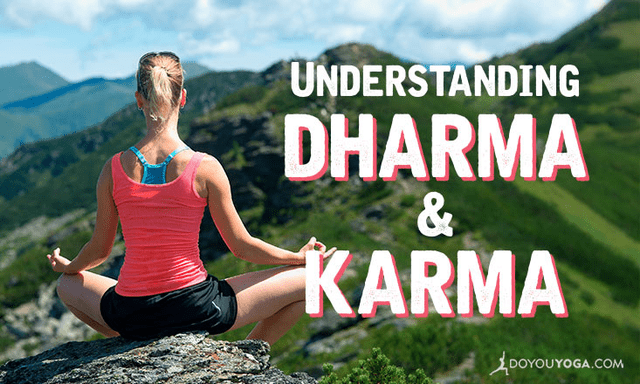Yoga classes these days will certainly make you sweat, tone your muscles, and stretch your tight hamstrings, but have you ever wondered why this “exercise” regimen is no passing trend and continues to gain popularity?
If you delve a little deeper into some of the philosophy behind the breathing and posing, you will discover a world rich with spiritual and psychological nourishment as well as the obvious physical benefits. Through asana, knowledge, and devotion, you can heal.
Today, we will explore some of the meaning of the Sanskrit words dharma and karma, as well as how these concepts apply to the modern day yoga practitioner both on the mat and in the world.
Dharma: Sense of Self
There is no single English word to succinctly illustrate the concept of dharma. Therefore, multiple definitions emerge, making it an esoteric and complex term.
I like to think of dharma as resonance: an instinctual knowing of right versus wrong. ~Judy Rukat
The Sanskrit root dhri means "to hold together." We have a drive to interconnect, whether that connection be biological in nature, spiritual, or both. Although we may appear separate, we have a mysterious "something" bonding us with others that gives us a sense of direction, purpose, and empathy.
That "something" is dharma.
Karma: Do As You Will
Karma is dharma in ACTION. The direct impact we have on each other through our thoughts, words, and deeds ultimately carves the path we are destined to follow. Causality indicates that one event causes another and that yesterday's decisions create your present circumstance.
We often attach "good" and "bad" to karma, such as payback for generous or malicious behaviors. While some validity may apply to that, karma spans entire lifespans and lifetimes, and therefore cannot be limited to isolated and specific events.
The perpetual cycle of karma is the result of making choices based on desires leading to attachments.
Nature of Evolution: Conflict Vs. Contentment
Is it human nature to feel dissatisfied? What inspires the ambition towards an infinite bigger, better, faster?
Some may argue that greed and selfishness cause this discontent, while others will say humankind’s survival depends on this behavior. Perhaps both sides contain elements of the truth; only in achieving balance between acting towards the good of self and the good of others can we sustain life.
The ability to remain present in the moment despite the urge to look toward the future reveals that in the here and now, peace exists. After all, as long as the breath flows and life continues, we should have no worries.
That ideal, however, does not fit in well with much of the hustle and bustle of our daily responsibilities. We cannot just let go of social obligations or neglect our spiritual wellbeing without consequence.
So, how do you balance your inner and outer consciousness?
Integration: The Union Between Dharma and Karma
Yogis will tell you that in order to manifest happiness, one must practice selfless service. Helping others, practicing compassion, and above all, ahimsa (non-violence) allows us to perform our dharma, transcend samsaras, and ultimately know peace within the self and within the community.
Of course, this simplified version doesn't take into account the myriad mental, emotional, and physical challenges that we confront daily. The practice of yoga builds endurance and teaches patience. It provides lessons in letting go of attachments which cause suffering.
Yoga shows us how to embrace spiritual liberation as we recover a fulfilled and whole sense of self.
Practice Makes Perfect—Or Does It?
Fulfilling one’s dharma and living without attachment to avoid creating negative karma is no easy task. Striving for perfection will only spawn further attachments. How can you stop this cycle?
Practice non-attachment, non-violence, and do your yoga. Yoga itself is a practice, because just like life, we can never “master” it. No matter how well you perform today’s asana, tomorrow will present unexpected challenges and require a whole new set of skills.
Yoga provides the tools to help us tune in to our dharma and to choose our actions in the present moment. All we can do is keep showing up, unrolling the mat, and participating in life’s infinite flow.
May you keep on flowing!


